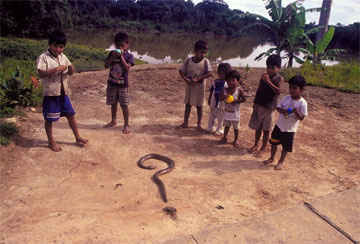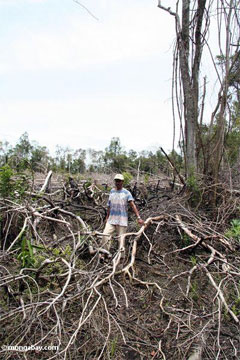Tropical deforestation rates to slow in future – new study
Rhett A. Butler, mongabay.com
April 6, 2006
As human population growth rates diminish in coming years deforestation rates are expected to slow according to research published in Biotropica online.
The report offers hope that reduced rates of forest conversion can stave off a future extinction crisis in the tropics, where most of the world’s biodiversity is found. Scientists estimate that as much as 50 percent of the planet’s terrestrial biodiversity is found in tropical rainforests distributed around the world but the United Nations recently warned that the current rate of extinction is running 100 to 1,000 times the normal background rate
“Trends such as slowing population growth and intense urbanization give reason to hope that deforestation will slow, regeneration will accelerate, and mass extinction of tropical forest species will be avoided,” report S.J. Wright, Smithsonian Tropical Research Institute and H.C. Muller-Landau, University of Minnesota, authors of the study.
Using UN population projections and area-specific relationships between both total and rural population density and present forest cover, Wright and Muller-Landau show that “the proportion of potential forest cover remaining correlates with human population density among countries in both the tropics and the temperate zone.” According to their forecast, deforestation rates will slow as human population growth decreases.
 Children surround a boa constrictor in San Antonio on the Rio Nanay in Peru Photo by Beth King of STRI. |
The projections come as figures released last year by the Food and Agriculture Organization of the United Nations (FAO) show that tropical deforestation rates increased 8.5 percent from 2000-2005 when compared with the 1990s, while loss of primary forests may have expanded by 25 percent over the same period. Overall, FAO estimates that 10.4 million hectares of tropical forest were permanently destroyed each year in the period from 2000 to 2005, an increase since the 1990-2000 period, when around 10.16 million hectares of forest were lost. Among primary forests, annual deforestation rose to 6.26 million hectares from 5.41 million hectares in the same period.
On a broader scale, FAO data indicates that primary forests are being replaced by less biodiverse plantations and secondary forests. Due to a significant increase in plantation forests, forest cover has generally been expanding in North America, Europe, and China while diminishing in the tropics. Industrial logging, conversion for agriculture (commercial and subsistence), and forest fires—often purposely set by people—are responsible for the bulk of global deforestation today.
However, say the authors of the study, because humans in rural settings contribute most to deforestation of tropical forests, declining rural populations will likely result in lower rates of forest loss and, in turn, reduced rates of biodiversity loss.
 Slash-and-burn agriculture in the rainforest of Kalimantan on the island of Borneo. Globally, more than half of deforestation results from subsistence clearing by small farmers. Photo by R. Butler. |
“Despite many caveats, our projections for forest cover provide hope that many tropical forest species will be able to survive the current wave of deforestation and human population growth,” said Wright and Mueller-Landau.
“Creative strategies to preserve tropical biodiversity might include policies to improve conditions in tropical urban settings to encourage urbanization and preemptive conservation efforts in countries with large areas of extant forest and large projected rates of future human population growth,” the authors conclude. “We hope that this first attempt inspires others to produce better models of future tropical forest cover and associated policy recommendations.”
Ref: S. Joseph Wright and Helene C. Mueller-Landau. The Future of
Tropical Forest Species. 2006. Biotropica.
The Smithsonian Tropical Research Institute (STRI), a unit of the
Smithsonian Institution, headquartered in Panama City, Panama, furthers
understanding of tropical nature and its importance to human welfare, trains
students to conduct research in the tropics and promotes conservation by
increasing public awareness of the beauty and importance of tropical
ecosystems. www.stri.org